Complete Solutions to SECTION-II of chapter SAMPLE PAPER 2017 of Class 10 book with complete answers and questions
| Class 10 | BIOLOGY |
| Chapter | SAMPLE PAPER 2017 |
| GURUKUL | SECTION-II |
| Number Of Questions | 65 |
| Academic Year | 2023-24 |
Study the diagram given below which represents a stage during the mitotic cell division and answer the questions that follow:

Identify the stage giving suitable reasons.02:03View SolutionStudy the diagram given below which represents a stage during the mitotic cell division and answer the questions that follow:
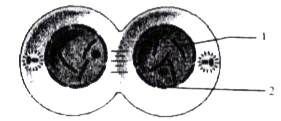
Name the parts numbered 1 and 2.01:09View SolutionStudy the diagram given below which represents a stage during the mitotic cell division and answer the questions that follow:

What is the technical term for the division of nucleus?01:54View SolutionStudy the diagram given below which represents a stage during the mitotic cell division and answer the questions that follow:

Mention the stage that comes before the stage shown in the diagram. Draw a neat labelled diagram of the stage mentioned.02:21View SolutionStudy the diagram given below which represents a stage during the mitotic cell division and answer the questions that follow:

Which is the cell division that results in half the number of chromosomes in daughter cells?01:46View SolutionDifferentiate between the following pairs on the basis of what is mentioned in brackets:
Active Transport and Diffusion [Significance in plants]02:17View SolutionDifferentiate between the following pair on the basis of what is mentioned within bracket.
Demography and Population density [Definition]02:48View SolutionDifferentiate between the following pairs on the basis of what is mentioned in brackets:
Antibiotic and Antibody (Source)01:36View SolutionDifferentiate between the following pair on the basis of what is mentioned within brackets:
Renal cortex and Renal medulla [Parts of the nephrons present]03:50View SolutionDifferentiate between the following pair on the basis of what is mentioned within bracket
NADP and ATP ( Expand the abbreviation)01:33View SolutionThe diagram given below represents a plant cell after being placed in a strong sugar solution . Study the diagram and answer the questions that follow:
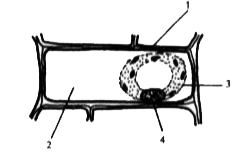
What is the state of the cell shown in the diagram?01:16View SolutionThe diagram given below represents a plant cell after being placed in a strong sugar solution . Study the diagram and answer the questions that follow:
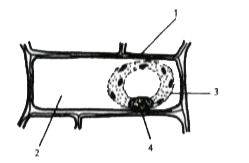
Name the structure that acts as a selectively permeable membrane.01:25View SolutionThe diagram given below represents a plant cell after being placed in a strong sugar solution . Study the diagram and answer the questions that follow:
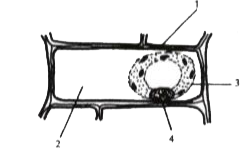
Label the parts numbered 1 to 4 in the diagram.01:31View SolutionThe diagram given below represents a plant cell after being placed in a strong sugar solution . Study the diagram and answer the questions that follow:

How can the above cell be brought back to its original condition? Mention the scientific term for the recovery of the cell.01:35View SolutionThe diagram given below represents a plant cell after being placed in a strong sugar solution . Study the diagram and answer the questions that follow:

State any two features of the above plant cell which is not present in animal cells.01:05View SolutionGiven below is a representation of kind of pollution. Study the same and answer the questions that follow :

Name the kind of pollution.01:14View SolutionList any three common sources of pollution.
01:19View SolutionMention three harmful effects of pollution on human health.
01:08View SolutionGiven below is a representation of kind of pollution. Study the same and answer the questions that follow :
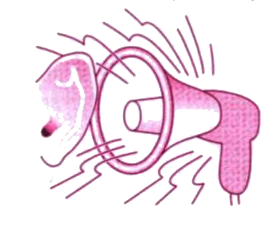
Explain the term 'Pollutant'.01:31View SolutionGiven below is a representation of kind of pollution. Study the same and answer the questions that follow :
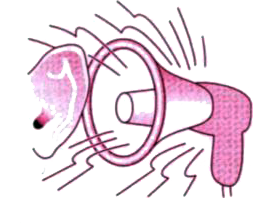
Name two soil pollutants.01:55View SolutionThe diagrams given below represent the relationship between a mouse and a physiological process that occurs in green plants. Study the diagrams and answer the questions that follow
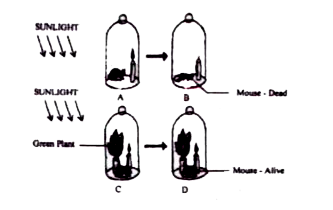
Name the physiological process occuring in the green plant that has kept the mouse alive02:41View SolutionThe diagrams given below represent the relationship between a mouse and a physiological process that occurs in green plants. Study the diagrams and answer the questions that follow
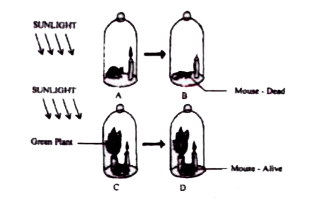
Explain the physiological process mentioned above02:57View SolutionThe diagrams given below represent the relationship between a mouse and a physiological process that occurs in green plants. Study the diagrams and answer the questions that follow
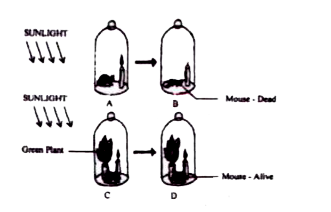
Why did the mouse die in bell jar B?01:47View SolutionThe diagrams given below represent the relationship between a mouse and a physiological process that occurs in green plants. Study the diagrams and answer the questions that follow

What is the significance of the process as stated in ( for life on earth?02:52View SolutionThe diagrams given below represent the relationship between a mouse and a physiological process that occurs in green plants. Study the diagrams and answer the questions that follow

Represent the above mentioned physiological process in the form of a chemical equation02:23View SolutionGive the exact location and one function of the following:
Prostate gland.03:25View SolutionState the exact location of the following:
Myelin sheath.02:54View SolutionGive the exact location of the following :
Islet of Langerhans02:22View SolutionMention the exact location of the following structures : Semi-circular canals.
01:47View SolutionMention the exact location of the Eustachian tube.
01:07View SolutionThe diagram shown below is the longitudinal section of a testis of man. Study it carefully and answer the questions that follow :
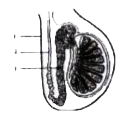
(i) Label the parts numbered 1 to 3 in the diagram.
(ii) In which part of the testis are the sperms ?
(iii) State the functions of the parts labelled 1 and 3 in the diagram.
(iv) Name the cells that secrete Testosterone.
(v) Draw a neat, labelled diagram of a sperm.03:22View SolutionThe diagram shown below is the longitudinal section of a testis of man. Study it carefully and answer the questions that follow :

(i) Label the parts numbered 1 to 3 in the diagram.
(ii) In which part of the testis are the sperms ?
(iii) State the functions of the parts labelled 1 and 3 in the diagram.
(iv) Name the cells that secrete Testosterone.
(v) Draw a neat, labelled diagram of a sperm.03:22View SolutionGiven below is a diagram of the lateral section of a testis of a man. Study the same and answer the questions that follow :
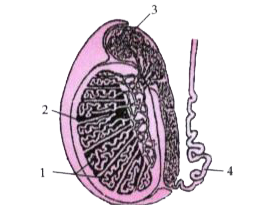
State the functions of the parts labelled 1 and 3.02:03View SolutionThe diagram shown below is the longitudinal section of a testis of man. Study it carefully and answer the questions that follow :

(i) Label the parts numbered 1 to 3 in the diagram.
(ii) In which part of the testis are the sperms ?
(iii) State the functions of the parts labelled 1 and 3 in the diagram.
(iv) Name the cells that secrete Testosterone.
(v) Draw a neat, labelled diagram of a sperm.03:22View SolutionThe diagram shown below is the longitudinal section of a testis of man. Study it carefully and answer the questions that follow :

(i) Label the parts numbered 1 to 3 in the diagram.
(ii) In which part of the testis are the sperms ?
(iii) State the functions of the parts labelled 1 and 3 in the diagram.
(iv) Name the cells that secrete Testosterone.
(v) Draw a neat, labelled diagram of a sperm.03:22View SolutionGive biological reason for the following statement: Some women have facial hair like beard and moustache.
02:46View SolutionGive biological reason for the following statement
Cutting of trees should be discouraged.01:48View SolutionGive biological reason for the following statements :
In some xerophytes, leaves are modified into spines.01:04View SolutionGive biological reason for the following:
There is frequent urination in winter than in summer.02:17View SolutionGive biological reason for the following:
The left ventricle of the heart has a thicker wall than the right ventricle.02:46View SolutionThe diagram given below represents a section of the human heart. Answer the questions that follow:

Which parts of heart are in the diastolic phase? Give a reason to support your answer.02:22View SolutionThe diagram given below represents a section of the human heart. Answer the questions that follow:
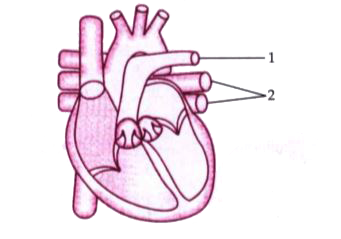
Label the parts numbered 1 and 2 in the diagram, What type of blood flows through them?01:16View SolutionThe diagram given below represents a section of the human heart. Answer the questions that follow:
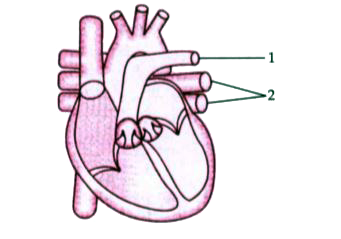
What causes the heart sounds "LUB' and 'DUB02:57View SolutionName the blood vessels that supply oxygenated blood to the heart muscles.
01:11View SolutionThe diagram given below represents a section of the human heart. Answer the questions that follow:
 04:12View Solution
04:12View SolutionGive appropriate biological technical terms for the following:
The type of immunity that exists in our body due to our genetic makeup.01:30View SolutionGive biological/ technical terms for the following:
The suppressed allele.03:16View SolutionName the following :
The accessory gland in human males whose secretion activates the sperms.01:09View SolutionName the following :
An apparatus to compare the rate of transpiration in a cut shoot.01:06View SolutionGive technical term :
The kind of twins formed from two fertilised eggs.02:26View SolutionGive biological/ technical terms for the following:
A pair of corresponding chromosomes of the same size and shape, one from each parent.02:34View SolutionGive appropriate biological technical terms for the following:
The mild chemical substance which when applied on the body kills germs.00:57View SolutionGive the biological/technical term for the following:
The type of waste generated in hospitals and pathological laboratories.00:55View SolutionGive the biological/technical terms for the following:
An Antiseptic substance present in tears.01:24View SolutionGive appropriate biological technical terms for the following:
Cellular components of blood containing haemoglobin.00:55View SolutionIn a homozygous pea plant, axial flowers (A) are dominant over terminal flowers (a).
What is the phenotype and genotype of the `F_1` generation if a plant bearing pure axial flowers is crossed with a plant bearing pure terminal flowers?03:02View SolutionIn a homozygous pea plant, axial flowers (A) are dominant over terminal flowers (a).
Draw a Punnett square board to show the gametes and offsprings when both the parent plants are heterozygous for axial flowers.02:37View SolutionIn a homozygous pea plant, axial flowers (A) are dominant over terminal flowers (a).
What is the phenotypic ratio and genotypic ratio of the above cross shown in (ii)?04:36View SolutionIn a homozygous pea plant, axial flowers (A) are dominant over terminal flowers (a).
State Mendel's Law of Dominance.03:11View SolutionIn a homozygous pea plant, axial flowers (A) are dominant over terminal flowers (a).
Name two genetic disorders commonly seen in human males.03:26View SolutionThe diagram given below is an external view of the human brain. Study the same and answer the questions that follow :
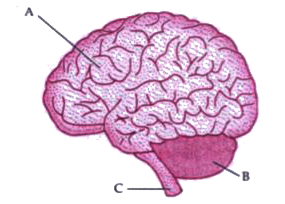
Name the parts labelled A, B and C in the diagram.02:57View SolutionThe diagram given below is an external view of the human brain. Study the same and answer the questions that follow :
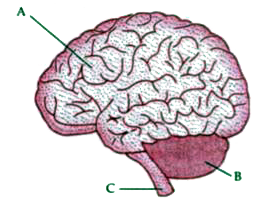
State the main functions of the parts labelled A and B.03:37View SolutionThe diagram given below is an external view of the human brain. Study the same and answer the questions that follow :

What are the structural and functional units of the brain ? How are the parts of these units arranged in A and C ?03:35View SolutionThe diagram given below is an external view of the human brain. Study the same and answer the questions that follow :

Mention the collective term for the membranes covering the brain.02:30View SolutionThe diagram given below is an external view of the human brain. Study the same and answer the questions that follow :
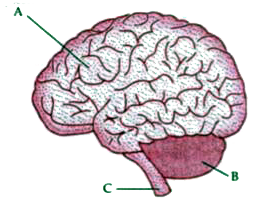
What is the function of Cerebrospinal fluid ?02:00View Solution
SECTION-II questions and complete solutions for chapter SAMPLE PAPER 2017 of EVERGREEN BIOLOGY (ENGLISH) of Class 10
